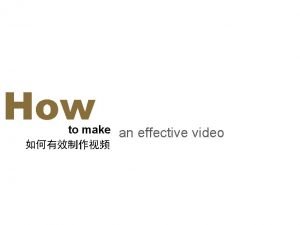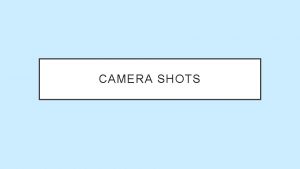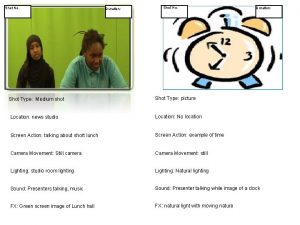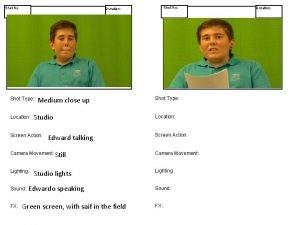Extreme wide shot Medium close up Very wide



- Slides: 3

Extreme wide shot Medium close up Very wide shot Wide shot Close up Camera shots Mid shot

• Tilt= moving the camera lens up or down while keeping its horizontal axis constant • Pan= moving the camera lens to one side or another. Look left then right is panning. • Zoom= zooming is one camera move that most people are probably familiar with. It involves changing the focal length of the lens to make the subject appear closer or further away in frame. • Pedestal= moving the camera up or down without changing its vertical or horizontal axis. A camera operator can do two types of pedestal up means “move the camera up” pedestal down means “move the camera down” • Dolly= motion towards or motion from. • Truck= trucking is like dollying, but involves motion left or right. • Handheld shooting= sometimes the action is moving too quickly or too unpredictably for the camera to be on a tripod. • Follow= the camera physically follows the subject a more or less constant distance. • Crab= a less common term for tracking or trucking. • Arc= an arc shot is a camera moves around the subject, somewhat like a tracking shot. • Aerial shot= an exterior show filmed from-hey!- the air. Often used to establish a (usually exotic) location. • Bridging shot= a shot that depends a shift in time or place, like a line moving across a animated map. • Close up= a shot that keeps only the face full in the frame. • Medium shot= the shot that utilises the most common framing in movies.

• Long shot= that depicts an entire character or object from head to foot. Not as long as establishing shot- wide shot. • Cowboy shot= a shot framed from mid thigh up, because of its recurrent use in westerns. • Deep focus= a shot that keeps the foreground, middle ground and background ALL in sharp focus. • Dutch tilt= a shot where the camera is tilted on its side to create a kooky angle. • Establishing shot= a shot at the head of the scene, that clearly shows the locale the action is set in. • Low angle shot= a shot looking up at a character or subject of ten making them look bigger in the frame. • High angle shot= a shot looking down on the character or subject often isolating them in the frame. • Locked down shot= a shot where the camera is fixed in one position while the action continues off screen.





